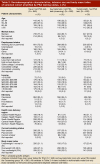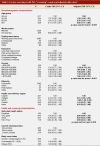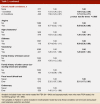Factors related to use of prostate cancer screening: the Alberta Tomorrow Project
- PMID: 20101288
- PMCID: PMC2801912
Factors related to use of prostate cancer screening: the Alberta Tomorrow Project
Abstract
Background: Very few data are available on the determinants of PSA testing in Canada, and it is a matter of debate whether prostate-specific antigen (PSA) screening in asymptomatic men age 50 and older with no risk factors for prostate cancer is useful. If PSA screening is introduced into the periodic health examination, it will be important to know what factors influence its use.
Objectives: The purpose of this study is to determine the factors associated with PSA testing among asymptomatic men age 50 and older participating in the Tomorrow Project in Alberta.
Methods: The Tomorrow Project is a population-based cohort study with over 11,000 participants accrued in Alberta since February 2003. Information was collected on medical history, sociodemographic factors, health status and lifestyle characteristics. This analysis includes 2136 men 50 years of age and older. The independent association between various factors and recent PSA screening is estimated using logistic regression.
Results: Approximately 50% of of the study group had received one or more PSA tests in their lifetime. Of these, 58% were asymptomatic for prostate disease at the time of their most recent PSA test. Variables independently associated with recent PSA screening for prostate cancer in this population include older age (>/= 65 versus < 55 years: adjusted odds ratio [OR] 2.60; 95% confidence interval [CI] 1.77-3.83), higher income (>/= $80,000 versus < $20,000, OR 1.97; 95% CI 1.09-3.55), region of health care delivery, perception of health status (good versus excellent health status; OR 0.65, CI 0.43-0.96], increased number of chronic health conditions (OR 1.73, 95% CI 1.10-2.71), and history of colorectal cancer screening with fecal occult blood test (OR 2.21; 95% CI 1.73-2.83).
Conclusions: An increasing proportion of men in Alberta are receiving a PSA test. A number of significant predictors of having a PSA test were identified, suggesting that factors other than having a clinical indication for prostate disease can influence decisions about PSA screening.
Conflict of interest statement
Competing interests: None declared.
Figures






Similar articles
-
Factors Related to Prostate-Specific Antigen-Based Prostate Cancer Screening in Primary Care: Retrospective Cohort Study of 120,587 French Men Over the Age of 50 Years.JMIR Public Health Surveill. 2018 Oct 23;4(4):e10352. doi: 10.2196/10352. JMIR Public Health Surveill. 2018. PMID: 30355559 Free PMC article.
-
Predictors of prostate cancer screening among health fair participants.Public Health. 2005 Aug;119(8):686-93. doi: 10.1016/j.puhe.2004.08.021. Epub 2005 Jan 22. Public Health. 2005. PMID: 15949522
-
Disparities Associated with Shared Decision-making in Prostate Cancer Screening.Eur Urol Focus. 2023 Nov;9(6):1008-1015. doi: 10.1016/j.euf.2023.04.013. Epub 2023 May 15. Eur Urol Focus. 2023. PMID: 37198068
-
Social ecological predictors of prostate-specific antigen blood test and digital rectal examination in black American men.J Natl Med Assoc. 2006 Apr;98(4):492-504. J Natl Med Assoc. 2006. PMID: 16623061 Free PMC article. Review.
-
Population screening for prostate cancer and emerging concepts for young men.Clin Prostate Cancer. 2003 Sep;2(2):87-97. doi: 10.3816/cgc.2003.n.015. Clin Prostate Cancer. 2003. PMID: 15040869 Review.
Cited by
-
Barriers and recommendations for colorectal cancer screening in Africa.Glob Health Action. 2023 Dec 31;16(1):2181920. doi: 10.1080/16549716.2023.2181920. Glob Health Action. 2023. PMID: 36820646 Free PMC article. Review.
-
Prevalence of and factors associated with mammography and prostate-specific antigen screening among World Trade Center Health Registry enrollees, 2015-2016.Prev Med Rep. 2018 May 10;11:81-88. doi: 10.1016/j.pmedr.2018.05.004. eCollection 2018 Sep. Prev Med Rep. 2018. PMID: 29984143 Free PMC article.
-
The influence of socioeconomic factors on health parameters in overweight and obese adults.PLoS One. 2013 Jun 5;8(6):e65407. doi: 10.1371/journal.pone.0065407. Print 2013. PLoS One. 2013. PMID: 23755228 Free PMC article.
-
Determinants of Prostate Cancer Screening Intentions of Young Black Men Aged 18 to 40 Years.J Racial Ethn Health Disparities. 2016 Nov 18. doi: 10.1007/s40615-016-0305-1. Online ahead of print. J Racial Ethn Health Disparities. 2016. PMID: 27864809
-
Socioeconomic Gradients in Prostate Cancer Incidence Among Canadian Males: A Trend Analysis From 1992 to 2010.Cancer Control. 2021 Jan-Dec;28:10732748211055272. doi: 10.1177/10732748211055272. Cancer Control. 2021. PMID: 34889129 Free PMC article.
References
-
- Canadian Cancer Society Early detection and screening for prostate cancer. 2006. [accessed 2007 Mar 9]. http://www.cancer.ca/ccs/internet/standard/0,3182,3172_10175_74550606_la....
-
- Kopec Jacek A, Goel Vivek, Bunting Peter S, Neuman Jan, Sayre Eric C, Warde Padraig, Levers Peter, Fleshner Neil. Screening with prostate specific antigen and metastatic prostate cancer risk: a population based case-control study. J Urol. 2005 Aug;174(2):495–9. doi: 10.1097/01.ju.0000165153.83698.42. discussion 499. - DOI - PubMed
-
- Labrie Fernand, Candas Bernard, Cusan Lionel, Gomez Jose Luis, Bélanger Alain, Brousseau G, Chevrette Eric, Lévesque Jacques. Screening decreases prostate cancer mortality: 11-year follow-up of the 1988 Quebec prospective randomized controlled trial. Prostate. 2004 May 15;59(3):311–318. doi: 10.1002/pros.20017. - DOI - PubMed
-
- Horninger Wolfgang, Berger Andreas, Pelzer Alexandre, Klocker Helmut, Oberaigner Wilhelm, Schönitzer Dieter, Severi Gianluca, Robertson Chris, Boyle Peter, Bartsch Georg. Screening for prostate cancer: updated experience from the Tyrol study. Can J Urol. 2005 Feb;12 Suppl 1:7–13. discussion 92-3. - PubMed
LinkOut - more resources
Full Text Sources
Research Materials
Miscellaneous
